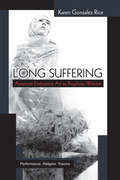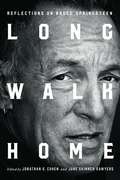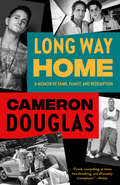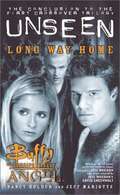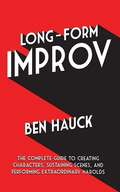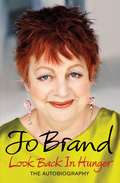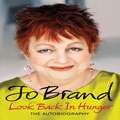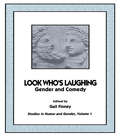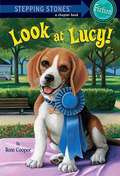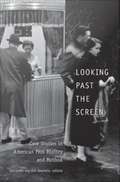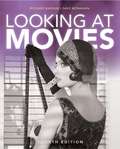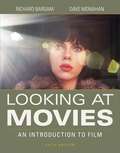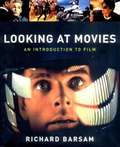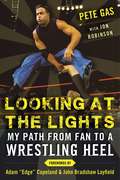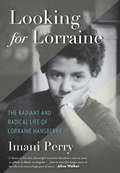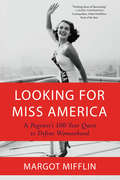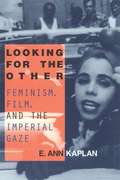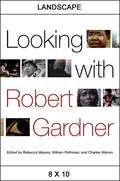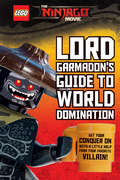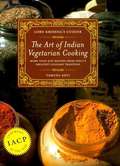- Table View
- List View
Long Story Short: Turning Famous Books into Cartoons
by Mr. FishA collection of cartoons, illustrations, and paintings that condense the complicated narratives of famous books into one-page works of art."A subversive volume that translates a series of complex works of literature into a single-page illustration . . . A variety of artists rise to a unique literary and visual challenge." —Kirkus ReviewsThe Catcher in the Rye. Lolita. Moby-Dick. Infinite Jest. I Know Why the Caged Bird Sings. A Room of One’s Own. Native Son. These are but a handful of classic works spectacularly distilled by Mr. Fish and a very talented group of painters, illustrators, graphic designers, and political cartoonists into succinct snapshots that are at times funny, sad, inspiring, rude, crude, beautiful, profound, stomach-turning, and mind-blowing.Includes original artwork from: Mr. Fish, Ted Rall, Stephanie McMillan, Sarah Awad, Eli Valley, Wes Tyrell, Tamara Knoss, Keith Henry Brown, Sam Henderson, Lodi Marasescu, Surag Ramachandran, Tami Knight, Eric J. Garcia, Marissa Dougherty, Siri Dokken, John G., Andy Singer, Tara Seibel, Gary Dumm, Clare Kolat, Nate Ulsh, Benjamin Slyngstad, Ron Hill, JP Trostle, John Kovaleski, and Beth McCaskey.
Long Suffering: American Endurance Art as Prophetic Witness
by Karen Gonzalez RiceLong Suffering productively links avant-garde performance practices with religious histories in the United States, setting contemporary performances of endurance art within a broader context of prophetic religious discourse in the United States. Its focus is on the work of Ron Athey, Linda Montano, and John Duncan, American artists whose performances involve extended periods of suffering. These unsettling performances can disturb, shock, or frighten audiences, leaving them unsure how to respond. The book examines how these artists work at the limits of the personal and the interpersonal, inflicting suffering on themselves and others, transforming audiences into witnesses, straining social relations, and challenging definitions of art and of ethics. By performing the death of self at the heart of trauma, strategies of endurance signal artists' attempts to visualize, legitimize, and testify to the persistent experience of being wounded. The artworks discussed find their foundations in artists' early experiences of religion and connections with the work of reformers from Angelina Grimké to Rev. Martin Luther King, Jr., who also used suffering as a strategy to highlight social injustice and call for ethical, social, and political renewal.
Long Walk Home: Reflections on Bruce Springsteen
by Richard Russo Eric Alterman David L. Ulin Paul Muldoon Wesley Stace Elijah Wald Daniel Wolff Peter Ames Carlin Regina Barreca Greil Marcus Kenneth Womack Jim Cullen Dermot Bolger Deepa Iyer Jefferson Cowie A. O. Scott Joel Dinerstein Nancy Bishop Gillian G. Gaar Louis Masur Natalie Adler Martyn Joseph Lauren Onkey Colleen Sheehy Frank Stefanko Irwin Streight Wayne SwanBruce Springsteen might be the quintessential American rock musician but his songs have resonated with fans from all walks of life and from all over the world. This unique collection features reflections from a diverse array of writers who explain what Springsteen means to them and describe how they have been moved, shaped, and challenged by his music. Contributors to Long Walk Home include novelists like Richard Russo, rock critics like Greil Marcus and Gillian Gaar, and other noted Springsteen scholars and fans such as A. O. Scott, Peter Ames Carlin, and Paul Muldoon. They reveal how Springsteen’s albums served as the soundtrack to their lives while also exploring the meaning of his music and the lessons it offers its listeners. The stories in this collection range from the tale of how “Growin’ Up” helped a lonely Indian girl adjust to life in the American South to the saga of a group of young Australians who turned to Born to Run to cope with their country’s 1975 constitutional crisis. These essays examine the big questions at the heart of Springsteen’s music, demonstrating the ways his songs have resonated for millions of listeners for nearly five decades. Commemorating the Boss’s seventieth birthday, Long Walk Home explores Springsteen’s legacy and provides a stirring set of testimonials that illustrate why his music matters.
Long Way Home
by Cameron DouglasFrom the scion of Hollywood royalty--son of Michael Douglas, grandson of Kirk Douglas--a moving, often shocking, ultimately inspiring memoir detailing his struggle to regain his dignity, humanity, and place in society after many years of drug abuse and almost eight years in prison.Cameron Douglas is born into wealth, privilege, and comfort. His parents are glamorous jet-setters, his father a superstar, his mother a beautiful socialite, his grandfather a legend. On the surface, his life seems golden. But by the age of thirty, he has taken a hellish dive: he's become a drug addict, a thief, and--after a DEA drug bust--a convicted drug dealer sentenced to five years in prison, with another five years added to his sentence while incarcerated. Eventually he will spend two years in solitary, where he manages, nonetheless, to hold fast to the brutal ethos of prison survival . . . until: he begins to reverse his savage transformation, to understand the psychological turmoil that has tormented him for years, and to prepare for what will be a profoundly challenging, but eventually deeply satisfying and successful, reentry into society at large.Sparing no one in his sphere--least of all himself--Cameron Douglas gives us a raw and unstintingly honest recounting of his harrowing, remarkable, and, in the end, inspiring life story.
Long Way Home (Buffy the Vampire Slayer and Angel: The Unseen Trilogy #3)
by Nancy Holder Jeff MariotteBuffy and Angel find themselves launched into a frightening reality where fierce dragons and other fairy-tale monstrosities rule supreme. Once they locate each other, they rally the missing teens -- including Salma -- and attempt to make their way through the inter-dimensional portal back to Sunnydale. Little do they know that two unlikely allies have also come through to alternity: Spike and the rogue Slayer, Faith, both with their own respective -- and complicated -- MOs. Back in L.A., gang violence and vigilantism are at a fever pitch. The Slayerettes -- now an extended unit -- are holding down the fort, awaiting Buffy and Angel's return. But Slayer and Vampire are feeling moral conflict that rivals the physical strain of demon-slaying: each wonders if a reality exists where their love could have survived. And when one of the duo's charges is suddenly killed, the portal to Sunnydale is sealed. Now, before they can worry about ridding their own universe of supernatural chaos, they've got to find a way to get back to it....
Long-Form Improv: The Complete Guide to Creating Characters, Sustaining Scenes, and Performing Extraordinary Harolds
by Ben HauckLong-Form Improv deftly teaches the wildly popular form of improvisation that is so foundational to the comedy stylings of many of today's top actors and thriving comedians. Crammed with innovative ideas for conceptualizing improvised scenework and "finding the game of the scene," this crisply written manual covers techniques for experienced improvisers, curious actors, and even non-actors. A complete long-form improv resource comprising topics like ideation and character creation, improvising scenes for extended periods of time and enhancing them--and even performing the most famous expression of long-form improv, the half-hour improvised form known as "The Harold"--this astute text is written in a friendly, supportive voice by an experienced improv teacher and professional actor whose own frustration in learning the craft drove an obsession to create a program free of confounding teachings and contradictory concepts. The book's groundbreaking infusion with drama theory and game theory brings new life to the teachings of the craft, breaking down various aspects of long-form improv into short chapters for swift, step-by-step intake of its vital lessons. Students of acting and long-form improv alike should expect Long-Form Improv to bolster their education and fast-track their course to improv greatness.
Look Back in Hunger
by Jo BrandJo Brand is one of Britain's funniest and best-loved comedians. With a sharp eye for the absurd and in her own unique voice she tells her story for the first time. What possessed her to become a professional comedian in the cut-throat world of stand-up comedy after ten years as a psychiatric nurse? How did she deal with late night drunken audiences? Raised in middle class comfort, she left home in her teens to live with someone entirely inappropriate. Her parents were aghast at her behaviour and attempted to rein in her excesses, finally giving up when she demonstrated that she was not headed for the life of a nun. From her early years growing up in a small south coast town with two brothers who toughened her up, to emerging on stage as 'The Sea Monster', Jo Brand tells it like it is with wit, candour and a wonderful sense that life can be ridiculous but there's always a funny side.Jo Brand is one of Britain's funniest and best-loved comedians. With a sharp eye for the absurd and in her own unique voice she tells her story for the first time.
Look Back in Hunger
by Jo BrandJo Brand is one of Britain's funniest and best-loved comedians. With a sharp eye for the absurd and in her own unique voice, she tells her story for the first time. What possessed her to become a professional comedian in the cut-throat world of stand-up comedy after ten years as a psychiatric nurse? How did she deal with late night drunken audiences? From her early years growing up in a small south coast town with two brothers who toughened her up, to emerging on stage as 'The Sea Monster', Jo Brand tells it like it is with wit and candour.(P)2009 Headline Digital
Look Who's Laugh: Gender and Comedy
by FinneyFirst Published in 1994. Routledge is an imprint of Taylor & Francis, an informa company.
Look at Lucy!
by Ilene CooperBobby is so proud of his puppy Lucy. She's a terrific friend, and a great dog. So when a local store has a pet contest, he happily enters Lucy in it. But it turns out the pet that wins the contest may be featured on TV-with its owner! Bobby is shy. He doesn't like attention. But can he face the spotlight . . . for Lucy? The third story of a boy and beagle's friendship is perfect for young dog lovers! From the Trade Paperback edition.
Look at This F*cking Hipster
by Joe MandeA hilarious send-up—and ironic celebration—of hipster culture based on the hugely popular websiteLook at this Fucking Hipster (LATFH.com) was born in April 2009 as a way to help author Joe Mande help his dad answer the question, "Is that a hipster?" Months later, with millions of followers and dozens of parodies, it has become a cultural phenomenon, referenced in media, newspapers, blogs, and more.Look at This Fucking Hipster is a collection of photos, snarky captions and short essays exploring—and, let's be honest, poking fun at—the wide world of hipster culture, from Williamsburg to Silver Lake and points between. Chapters cover types of hipsters, celebrity hipsters, hipsters through the ages, hipster love connections, and the next generation of hipsters (AKA hipster babies).
Looking Past the Screen: Case Studies In American Film History and Method
by Eric Smoodin Jon LewisFilm scholarship has long been dominated by textual interpretations of specific films. Looking Past the Screen advances a more expansive American film studies in which cinema is understood to be a social, political, and cultural phenomenon extending far beyond the screen. Presenting a model of film studies in which films themselves are only one source of information among many, this volume brings together film histories that draw on primary sources including collections of personal papers, popular and trade journalism, fan magazines, studio publications, and industry records. Focusing on Hollywood cinema from the teens to the 1970s, these case studies show the value of this extraordinary range of historical materials in developing interdisciplinary approaches to film stardom, regulation, reception, and production. The contributors examine State Department negotiations over the content of American films shown abroad; analyze the star image of Clara Smith Hamon, who was notorious for having murdered her lover; and consider film journalists' understanding of the arrival of auteurist cinema in Hollywood as it was happening during the early 1970s. One contributor chronicles the development of film studies as a scholarly discipline; another offers a sociopolitical interpretation of the origins of film noir. Still another brings to light Depression-era film reviews and Production Code memos so sophisticated in their readings of representations of sexuality that they undermine the perception that queer interpretations of film are a recent development. Looking Past the Screen suggests methods of historical research, and it encourages further thought about the modes of inquiry that structure the discipline of film studies. Contributors. Mark Lynn Anderson, Janet Bergstrom, Richard deCordova, Kathryn Fuller-Seeley, Sumiko Higashi, Jon Lewis, David M. Lugowski, Dana Polan, Eric Schaefer, Andrea Slane, Eric Smoodin, Shelley Stamp
Looking at Movies: An Introduction to Film
by Richard Barsam Dave MonahanLooking at Movies is the most effective introduction to film analysis available. From its very first chapter, Looking at Movies provides students with the tools they need to become perceptive viewers of film. The Fourth Edition is not only more comprehensive, but also more accessible and sophisticated in its integration of media.
Looking at Movies: An Introduction to Film
by Richard Barsam Dave MonahanLooking at Movies; the most effective introduction to film analysis available.
Looking at Movies: An Introduction to Film
by Richard BarsamIn using the work "looking" in the title of his introductory college-level film text, Barsam (emeritus, film studies, Hunter College) hopes to demonstrate that students need to actively examine relationships of form and content in cinema. Primarily focused on introducing film analysis, the text does include some discussion of film history, theory, and production.
Looking at the Lights: My Path from Fan to a Wrestling Heel
by Adam Copeland Jon Robinson Pete Gas John LayfieldHow did an untrained former college football player end up in the middle of a ring, wrestling during the highest-rated segment during the WWE’s acclaimed Attitude Era?That’s the story behind Looking at the Lights. As a childhood friend of Shane McMahon, Pete Gas was given the opportunity most only pray for. Beginning with appearances to interfere in McMahon’s matches, his role blossomed into becoming a full-fledge wrestler and leading the Mean Street Posse to WrestleMania, becoming one of the most fascinating success stories of the era.From his humble upbringing and friendship with Shane (and the McMahon family as a whole), Gas shares how a 9-to-5 average Joe got the chance of a lifetime and made the most out of it.But getting your foot in the door is one thing; staying is a completely different animal. With all eyes on him, knowing his lack of training and meal ticket being the boss’s son, Gas knew he had to win over all those doubters: from the fans and announcers to the wrestlers themselves.Knowing he had to prove himself, Gas took beatings, chair shots, and additional training to not only show that he could wrestle, but that he belonged with such superstars as The Rock, "Stone Cold” Steve Austin, and The Undertaker.Featuring forewords by Edge and JBL, who famously nailed Gas in the head with a steel chair, readers will get an inside look into not only the training and sacrifice these athletes go through, but the behind-the-scenes workings of a day in the WWE.
Looking for Lorraine: The Radiant and Radical Life of Lorraine Hansberry
by Imani PerryA revealing portrait of one of the most gifted and charismatic, yet least understood, Black artists and intellectuals of the twentieth century. <p><p> Lorraine Hansberry, who died at thirty-four, was by all accounts a force of nature. Although best-known for her work A Raisin in the Sun, her short life was full of extraordinary experiences and achievements, and she had an unflinching commitment to social justice, which brought her under FBI surveillance when she was barely in her twenties. While her close friends and contemporaries, like James Baldwin and Nina Simone, have been rightly celebrated, her story has been diminished and relegated to one work—until now. <p> In 2018, Hansberry will get the recognition she deserves with the PBS American Masters documentary “Lorraine Hansberry: Sighted Eyes/Feeling Heart” and Imani Perry’s multi-dimensional, illuminating biography, Looking for Lorraine. <p> After the success of A Raisin in the Sun, Hansberry used her prominence in myriad ways: challenging President Kennedy and his brother to take bolder stances on Civil Rights, supporting African anti-colonial leaders, and confronting the romantic racism of the Beat poets and Village hipsters. Though she married a man, she identified as lesbian and, risking censure and the prospect of being outed, joined one of the nation’s first lesbian organizations. Hansberry associated with many activists, writers, and musicians, including Malcolm X, Langston Hughes, Duke Ellington, Paul Robeson, W.E.B. Du Bois, among others. <p> Looking for Lorraine is a powerful insight into Hansberry’s extraordinary life—a life that was tragically cut far too short.
Looking for Miss America: A Pageant's 100-Year Quest to Define Womanhood
by Margot MifflinFrom an author praised for writing “delicious social history” (Dwight Garner, The New York Times) comes a lively account of memorable Miss America contestants, protests, and scandals—and how the pageant, nearing its one hundredth anniversary, serves as an unintended indicator of feminist progressLooking for Miss America is a fast–paced narrative history of a curious and contradictory institution. From its start in 1921 as an Atlantic City tourist draw to its current incarnation as a scholarship competition, the pageant has indexed women’s status during periods of social change—the post–suffrage 1920s, the Eisenhower 1950s, the #MeToo era. This ever–changing institution has been shaped by war, evangelism, the rise of television and reality TV, and, significantly, by contestants who confounded expectations.Spotlighting individuals, from Yolande Betbeze, whose refusal to pose in swimsuits led an angry sponsor to launch the rival Miss USA contest, to the first black winner, Vanessa Williams, who received death threats and was protected by sharpshooters in her hometown parade, Margot Mifflin shows how women made hard bargains even as they used the pageant for economic advancement. The pageant’s history includes, crucially, those it excluded; the notorious Rule Seven, which required contestants to be “of the white race,” was retired in the 1950s, but no women of color were crowned until the 1980s.In rigorously researched, vibrant chapters that unpack each decade of the pageant, Looking for Miss America examines the heady blend of capitalism, patriotism, class anxiety, and cultural mythology that has fueled this American ritual.
Looking for the Other: Feminism, Film and the Imperial Gaze
by E. Ann KaplanWhat happens when white people look at non-whites? What happens when the gaze is returned? Looking for the Other responds to criticisms leveled at white feminist film theory of the 1970s and 1980s for its neglect of issues to do with race. It focuses attention on the male gaze across cultures, as illustrated by women filmmakers of color whose films deal with travel. Looking relations are determined by history, tradition, myth; by national identity, power hierarchies, politics, economics, geographical and other environment. Travel implicitly involves looking at, and looking relations with, peoples different from oneself. Featured films include Birth of a Nation, The Cat People, Home of the Brave, Black Narcissus, Chocolat, and Warrior Marks. Featured filmmakers include D.W.Griffith, Jacques Tourneur, Michael Powell, Julie Dash, Pratibha Parmar, Trinh T. Min-ha, and Claire Denis.
Looking with Robert Gardner (SUNY series, Horizons of Cinema)
by Rebecca Meyers; William Rothman; Charles WarrenDuring his lifetime, Robert Gardner (1925–2014) was often pigeonholed as an ethnographic filmmaker, then criticized for failing to conform to the genre's conventions—conventions he radically challenged. With the release of his groundbreaking film Dead Birds in 1963, Gardner established himself as one of the world's most extraordinary independent filmmakers, working in a unique border area between ethnography, the essay film, and poetic/experimental cinema. Richly illustrated, Looking with Robert Gardner assesses the range and magnitude of Gardner's achievements not only as a filmmaker but also as a still photographer, writer, educator, and champion of independent cinema. The contributors give critical attention to Gardner's most ambitious films, such as Dead Birds (1963, New Guinea), Rivers of Sand (1975, Ethiopia), and Forest of Bliss (1986, India), as well as lesser-known films that equally exemplify his mode of seeking anthropological understanding through artistic means. They also attend to his films about artists, including his self-depiction in Still Journey OnM (2011); to his roots in experimental film and his employment of experimental procedures; and to his support of independent filmmakers through the Harvard Film Study Center and the television series Screening Room, which provided an opportunity for numerous important film and video artists to present and discuss their work.
Loose Women: Our Life Lessons Revealed
by ITV Ventures Limited*For 20 years the Loose Women panellists have been entertaining the nation with their forthright opinions on the vagaries of modern life. For the first time, they have come together to share intimate thoughts, fears, memories and anecdotes that are both thought-provoking and entertaining in equal measure.Loose Women: Let Loose! takes on the essential subjects of Love, Sex, Self-Esteem, Friendships, Family, Body Image and Wellness. Whether it is parenting advice from Nadia ('It's important to have a support network when you're a new parent'); Gloria's experience with bereavement ('Losing a child changes you, you can't be the same person'); Coleen's feelings about love ('I do believe there is "the one" - for now'); or Janet's take on mental health ('It doesn't need to be triggered by splitting up or a death, it could be happening in small ways'), there are stories that have never been shared before alongside the show's best bits, making Loose Women: Let Loose! a hilarious and honest guide to handling life's ups and downs as a 21st-century woman.
Loose Women: Our Life Lessons Revealed
by ITV Ventures LimitedFor 20 years the Loose Women panellists have been entertaining the nation with their forthright opinions on the vagaries of modern life. For the first time, they have come together to share intimate thoughts, fears, memories and anecdotes that are both thought-provoking and entertaining in equal measure.Loose Women: Let Loose! takes on the essential subjects of Love, Sex, Self-Esteem, Friendships, Family, Body Image and Wellness. Whether it is parenting advice from Nadia ('It's important to have a support network when you're a new parent'); Gloria's experience with bereavement ('Losing a child changes you, you can't be the same person'); Coleen's feelings about love ('I do believe there is "the one" - for now'); or Janet's take on mental health ('It doesn't need to be triggered by splitting up or a death, it could be happening in small ways'), there are stories that have never been shared before alongside the show's best bits, making Loose Women: Let Loose! a hilarious and honest guide to handling life's ups and downs as a 21st-century woman.
Lord Garmadon's Guide to World Domination ( LEGO NINJAGO Movie)
by Meredith Rusu<P>Get your conquer on with help from Lord Garmadon, Ninjago's one and only foul-but-funny warlord! Lloyd's evil dad shares his wisdom on everything from fighting the ninja to building a volcano lair to conquering family-style. <P>Kids are sure to laugh maniacally at Garmadon's hilarious tips and tricks on how to dominate Ninjago City and, yes, the world.
Lord Krishna's Cuisine: The Art of Indian Vegetarian Cooking
by Yamuna DeviFrom the book: From appetizers, soups and salads to light meals and savories, beverages and sweets here are easy-to-follow instructions for glorious foods, simply prepared in an American kitchen.
Lore of the Lumber Camps
by E. C. BeckA collection of songs/ballads and stories of the Michigan lumber camps of the 1800's.

